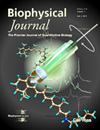Disease-related miRNA mutations are associated with mature miRNA secondary structure changes.
IF 3.1
3区 生物学
Q2 BIOPHYSICS
引用次数: 0
Abstract
MicroRNAs (miRNAs) are ubiquitous short RNAs regulating gene expression in many organisms, including humans. How the secondary structure (SS) of a mature miRNA affects its regulatory function remains an open question. Here we investigate this question through computational SS predictions of miRNA point mutants. We explore the mutational neighborhoods of miRNAs with association to human diseases, including cancer. We focus on possible SS changes independent of target-site complementarity, by leaving the seed region unchanged. We formulate metrics of the SS differences between such mutants and their wild types (WTs), and test whether disease-associated mutations tend to differ from others in terms of these metrics by comparing our results with the miRNASNP-v3 database. We find that disease-related mutants tend to have a higher probability of being fully unfolded than their WT; this and other SS-related measures are statistically significant at the database level. This is confirmed when we restrict the analysis to the better-validated miRNAs encoded by genes that appear in the manually curated MiRGeneDB database. With the same approach, we identify a subset of individual miRNAs for which SS changes are most likely to be related to disease. These are hsa-miR-1269b, hsa-miR-4537, hsa-miR-4477b, hsa-miR-4641, and hsa-miR-6821-3p; when focussing on the higher-confidence MiRGeneDB miRNAs, we find that hsa-miR-485-5p and hsa-miR-1908-3p are the ones for which SS changes are most likely to be linked to disease. In addition, we show that there are pairs of known miRNA WTs differing only by disease-related point mutations outside the seed region and exhibit very different SS. These pairs include hsa-miR-1269a-hsa-miR-1269b, and hsa-miR-3689a-3p-hsa-miR-3689b-3p.疾病相关miRNA突变与成熟miRNA二级结构改变相关。
MicroRNAs (miRNAs)是在包括人类在内的许多生物体中普遍存在的调节基因表达的短rna。成熟miRNA的二级结构(SS)如何影响其调控功能仍然是一个悬而未决的问题。在这里,我们通过miRNA点突变的计算SS预测来研究这个问题。我们探索与人类疾病(包括癌症)相关的mirna的突变邻域。我们通过保持种子区不变来关注独立于目标位点互补性的SS变化。我们制定了这些突变体及其野生型(WTs)之间SS差异的指标,并通过将我们的结果与miRNASNP-v3数据库进行比较,测试疾病相关突变在这些指标方面是否倾向于与其他突变不同。我们发现,与疾病相关的突变体往往比它们的WT有更高的完全展开的可能性;这个和其他与ss相关的度量在数据库级别上具有统计意义。当我们将分析限制在人工管理的MiRGeneDB数据库中出现的基因编码的经过更好验证的miRNAs时,这一点得到了证实。通过同样的方法,我们确定了一个单独的mirna子集,其中SS的变化最有可能与疾病相关。这些是hsa-miR-1269b, hsa-miR-4537, hsa-miR-4477b, hsa-miR-4641和hsa-miR-6821-3p;当关注更高置信度的MiRGeneDB mirna时,我们发现hsa-miR-485-5p和hsa-miR-1908-3p是SS变化最有可能与疾病相关的mirna。此外,我们发现有对已知的miRNA WTs仅因种子区外的疾病相关点突变而不同,并表现出非常不同的SS。这些对包括hsa-miR-1269a-hsa-miR-1269b和hsa-miR-3689a-3p-hsa-miR-3689b-3p。
本文章由计算机程序翻译,如有差异,请以英文原文为准。
求助全文
约1分钟内获得全文
求助全文
来源期刊

Biophysical journal
生物-生物物理
CiteScore
6.10
自引率
5.90%
发文量
3090
审稿时长
2 months
期刊介绍:
BJ publishes original articles, letters, and perspectives on important problems in modern biophysics. The papers should be written so as to be of interest to a broad community of biophysicists. BJ welcomes experimental studies that employ quantitative physical approaches for the study of biological systems, including or spanning scales from molecule to whole organism. Experimental studies of a purely descriptive or phenomenological nature, with no theoretical or mechanistic underpinning, are not appropriate for publication in BJ. Theoretical studies should offer new insights into the understanding ofexperimental results or suggest new experimentally testable hypotheses. Articles reporting significant methodological or technological advances, which have potential to open new areas of biophysical investigation, are also suitable for publication in BJ. Papers describing improvements in accuracy or speed of existing methods or extra detail within methods described previously are not suitable for BJ.
 求助内容:
求助内容: 应助结果提醒方式:
应助结果提醒方式:


